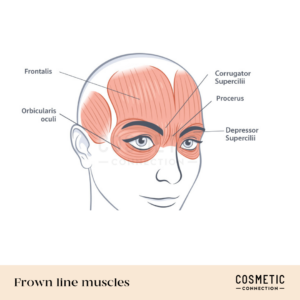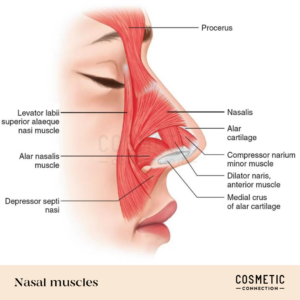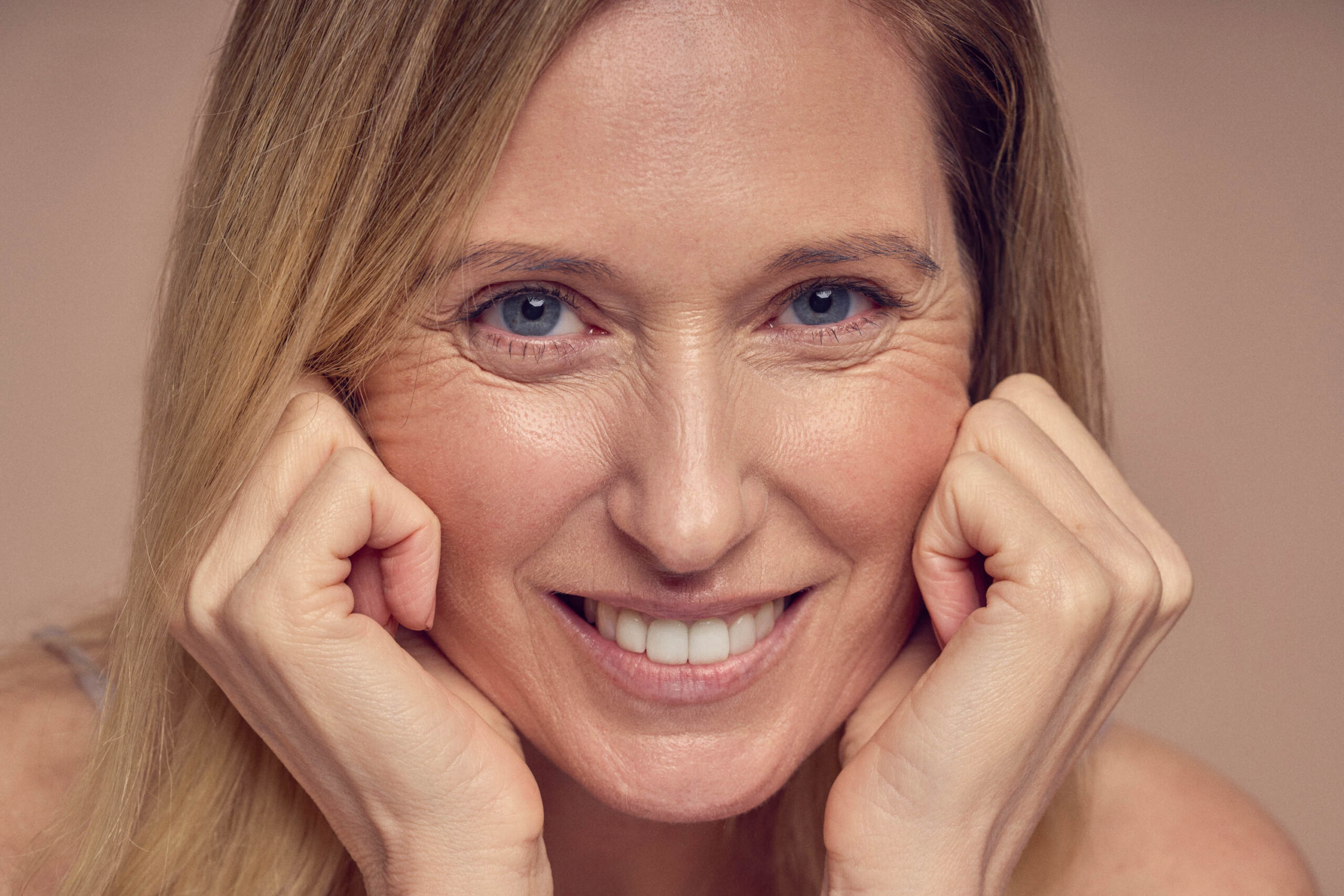Anti-wrinkle injections are one of the most commonly performed treatments here at Cosmetic Connection. We perform thousands of cosmetic treatments across our clinics in Melbourne and Sydney every year. The satisfaction rate for anti-wrinkle treatment is very high, however some people may have questions or concerns after anti-wrinkle injections. These are usually very simple to answer and address. There is only a very small chance that you may have an issue after anti-wrinkle treatment. ‘Common’ refers to the fact that the issues we discuss here are the ones that occur the most, but they are rare issues.
This guide discusses concerns people may have about anti-wrinkle injections, what can be done about them, and how to prevent them.
Frown line anti-wrinkle injections
Frown line anti-wrinkle injections are on of the most commonly performed treatments at cosmetic clinic in Australia.
‘I can still frown after my anti-wrinkle treatment’
If after you anti-wrinkle kicks in you can still frown, this is not necessarily a problem. Anti-wrinkle results exist on a continuum, all the way to completely paralysing the frown muscles (which gives a frozen look). If you want a natural result, then we should aim to preserve some movement by performing a conservative treatment. The downside of preserving movement is that the effect will usually wear off faster, although you will still be able to make facial expressions.
Higher amounts of anti-wrinkle product are needed if you want a long-lasting and strong result. If this was your treatment goal and you still have movement, then there are 3 possible explanations.
The first is that you did not have enough anti-wrinkle product. This can be easily rectified by increasing your dose at your next treatment.
The second is that the product was not placed precisely. You can avoid this by only visiting an experienced, doctor-led cosmetic clinic.
The third is that you may be developing immunity to the anti-wrinkle product. Fortunately, this is rare, but you’ll need to take a break from anti-wrinkle injections for 1-2 years to try and let the immunity wear off.
‘I can still see frown lines after treatment’
Not all frown lines can be adequately treated with frown line anti-wrinkle injections. Deep frown lines that are visible at rest are known as static lines. Static lines occur when there is damage to the skin, and must be treated by combining anti-wrinkle injections, dermal fillers and skin tightening treatments.
Some people find that they can gradually improve static frown lines by having consistent anti-wrinkle treatments. However, you should consider frown line fillers if your result from frown line anti-wrinkle injections is not sufficient.
‘The outer part of my frown lines still move after treatment’
The corrugator frown line muscles extend outwards from the inner eyebrow, and cause movement and wrinkles above the mid-point of your eyebrows. If you can still move the outer aspect of your frown lines after your treatment, then corrugator tails have not been treated with enough anti-wrinkle product.
To address this, you can simply increase the amount of anti-wrinkle product placed in the outer aspect of your corrugator tails at your next treatment.

‘I have a droopy eyelid after treatment’
A legitimate eyelid droop after frown line anti-wrinkle injections is very rare. It occurs when the injected anti-wrinkle product spreads into the levator palpabrae superioris eyelid muscle. This muscle is responsible for opening the eyes, and when weakened by anti-wrinkle product, causes they eyelid to droop.

An example of a true eyelid ptosis. Image credit: news.com.au
Eyelid ptosis can be avoided by being very careful when injecting anti-wrinkle product. Injecting with a safety margin above the upper eyelid reduces the risk. Unfortunately if an eyelid ptosis does occur there is not much that can be done, aside from waiting for the effect to wear off.
There is some evidence that Iopidine (apraclonidine) eyedrops can improve an eyelid ptosis by stimulating the muscles that lift the upper eyelids, but clinically the benefit is hard to measure.
‘I have more wrinkles on my nose after frown line anti-wrinkle injections’
When making a frown expression, some people also notice scrunch lines across their nose. These are known as bunny lines, and are caused by the contraction of the nasalis muscle. When performing frown line anti-wrinkle injections, the nasalis muscle can become hyperactive in compensation if it has not been treated. This causes the scrunch lines to appear more pronounced.

It is easy to avoid compensation of your scrunch lines by also treating the bunny lines with anti-wrinkle injections when having frown line treatment.
Forehead line anti-wrinkle injections
It can be challenging to achieve a great result with forehead anti-wrinkle injections. This is because the forehead muscles that causes horizontal forehead lines is the only brow lifting muscle on your face. Your eyebrows can become droopy and heavy, or even misshapen if your forehead is not treated correctly.
‘My forehead anti-wrinkle wears off quickly’
The longevity of your anti-wrinkle result is determined by the amount of product injected, and how precisely it has been placed. It is not a good idea to use high doses of anti-wrinkle product to treat forehead lines. This is because if the forehead muscle is overly weakened, your brows will drop, making you look angry, tired and older. As we need to use more conservative doses of anti-wrinkle on the forehead to avoid this, the longevity will be shorter. People with low-set eyebrows, excess upper eyelid skin or weak forehead muscles are more prone to heavy and saggy eyebrows.
If you want your forehead anti-wrinkle result to last longer, it is best to start conservatively and build up your dose over time. Realistically, you will need to choose whether you would prefer a long-lasting result or lifted, youthful eyebrows, because it is not usually possible to have both. You can also treat your frown line and crow’s feet at the same time. These muscles pull the brows down, and treating them creates a brow lift that offsets the weaker forehead muscle. This allows us to use higher doses for your forehead treatment and increase the longevity.

‘My brows feel heavy after anti-wrinkle injections’, ‘My forehead feels heavy after anti-wrinkle injections’
The frontalis forehead muscle is the only muscle that lifts your eyebrows. It is also the muscle that causes horizontal forehead wrinkles. If you have had too much anti-wrinkle product placed in the frontalis muscle, then you may get heavy eyebrows. You should have a more conservative treatment on your forehead to avoid this, but in doing so the longevity will be slightly less.
Most people prefer to have shorter longevity but avoid heavy brows, as this looks the most natural and youthful.
‘My eyebrows are too peaked after forehead anti-wrinkle injections’
This is commonly known as Spocking, Spock-brow or Mephisto brows and occurs when the outer forehead muscle has not been adequately treated with anti-wrinkle. The untreated areas compensate for the weakened central forehead muscles, creating a strong lifting effect on the eyebrow tails.

An example of eyebrow spocking. Note: not a patient of Cosmetic Connection.
Spocked eyebrows are very simple to treat. A small amount of anti-wrinkle product can be placed above the peaked point of the eyebrows to relax the outer forehead frontalis muscle, and return your eyebrows to a normal shape and position.
‘I look frozen after forehead anti-wrinkle injections’, ‘My forehead looks shiny after anti-wrinkle injections’
A frozen or shiny looking forehead is caused when too much anti-wrinkle product has been placed in the forehead muscle. Anti-wrinkle injections work by relaxing the treated muscle. If too much product is placed, the muscle will be completely paralysed, resulting in a frozen and expressionless appearance. A shiny forehead can also occur if too much anti-wrinkle product is placed. This occurs when the skin is so smooth that light reflects of its surface too effectively, and is a giveaway that someone has had anti-wrinkle treatment.
The only way to manage a frozen or shiny appearance is to let the effect wear off gradually. To avoid the problem recurring, you should have less anti-wrinkle product placed in your forehead. However, this will reduce the longevity of your result.
Crow’s feet anti-wrinkle injections
Crow’s feet are a very popular anti-wrinkle treatment with men and women in Australia. When done correctly, crow’s feet anti-wrinkle injections can make you appear refreshed and rested, open up your eyes and preserve your expression.
‘I still have wrinkles under my eyes after crows feet injections’
Crow’s feet wrinkles can extend all the way around and under the lower eyelid. It is usually ok to treat lower eyelid wrinkles and a jelly roll, but only if the skin has good elasticity. If the skin is starting to sag, treating under eye crow’s feet can cause the eyelid to fall away from the eyeball. This can give you you dry eyes.
When crow’s feet are treated without including the under eye wrinkles, the under eye wrinkles may appear more prominent by comparison.
You can improve under eye wrinkles in different ways:
- Explore skin tightening treatments like radiofrequency skin needling.
- Consider a lower belpharoplasty (eyelid lift).
To avoid under eye wrinkles looking worse by comparison:
- Treat the outer crow’s feet more conservatively.
‘My cheeks look odd after crows feet injections’
Lower crow’s feet are caused by both the eye muscles and the cheek muscles. If your lower crow’s feet are treated too aggressively with anti-wrinkle injections, then your cheeks may look different, especially when smiling. This is often referred to as chipmunk cheeks, because they look flat and bunched.
You can avoid this problem by treating the lower crow’s feet conservatively. Combining lower crow’s feet anti-wrinkle treatment with cheek filler and skin tightening can also be used to achieve more pronounced improvements without causing chipmunk cheeks.
‘My crows feet anti-wrinkle wears off quickly’
The longevity of crow’s feet anti-wrinkle treatment depends on the following:
- Amount of anti-wrinkle product injected (number of units).
- The precision of the injections.
- How strong your obicularis oculi muscle area (the muscles that cause crow’s feet).
- How frequently you are getting crow’s feet anti-wrinkle injections.
The only way to increase the longevity of your crow’s feet anti-wrinkle treatment is to use more product, be consistent in your treatments, and make sure your procedure is done carefully at a reputable cosmetic clinic.
Different brands of anti-wrinkle product all work the same way and last the same amount of time when equivalent amounts are used.
‘My smile looks fake after crows feet anti-wrinkle injections’
An authentic (duchenne) smile is perceived when you have small wrinkles around the outer aspect of your eyes. Your smile may look unnatural if you have had too much anti-wrinkle product injected in your crow’s feet. If this occurs, you’ll need to wait for the effect to wear off, which generally takes up to 3-4 months.
To avoid a change in your smile after crow’s feet anti-wrinkle, you should have less product injected. The downside of using less anti-wrinkle units for your crow’s feet is that the result will not last as long.
Summary
There are many pitfalls when it comes to anti-wrinkle injections. Good practitioners will be able to assess your wrinkles, understand your goals, and design a bespoke anti-wrinkle treatment that achieves a result that you are satisfied with. There is always a balance between too conservative and too aggressive a treatment, and finding that balance is the key to a good result.
At Cosmetic Connection, we are passionate about empowering you to make an informed choice about your treatments.
Check out our dedicated anti-wrinkle injections page, or send us an enquiry with your questions if you are interested in anti-wrinkle injections.
You can also book in for a comprehensive consultation and anti-wrinkle treatment with us.


